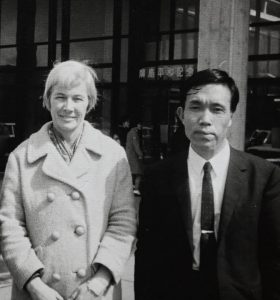My Life — Interview with Hiromu Morishita (1930–), A-bomb survivor and teacher, Part 12: WFC
May 5, 2022
Aimed to build a bridge to the world
While teaching at Hatsukaichi High School, Hiromu Morishita initiated another large-scale survey of attitudes.
The survey subjects were the classmates of my alma mater Hiroshima First Middle School (present-day Kokutaiji High School). Its origins were in our class reunions. When we met, we would usually talk about such topics as, “That time was difficult, wasn’t it?” or “What are you doing now?” I noticed that ways of life and thinking after the atomic bombing were completely different even among classmates who experienced the bombing at the same location in the same way. That made me think it might be possible to learn about the damage wrought by the atomic bombing in a systematic way, and so I made up my mind to conduct another survey.
The first survey took place in 1967. But its content was very simple. I conducted the second survey, to which I added more questions, in 1974. The questionnaire was 15 pages in length and asked about what respondents felt at the moment of the bombing, their actions afterward, and what their life was like after graduation from school. A total of 35 classmates responded, and those original questionnaires are stored at the Hiroshima Peace Memorial Museum, located in the city’s Naka Ward. The respondents who filled out the questionnaire, their family members, and researchers all have access to the documents.
In 1986, he assumed the post as chair of the World Friendship Center (WFC) while still working as a teacher at Hatsukaichi High School.
When I visited Tomin Harada (who died in 1999) at the hospital he was staying in, he pleaded with me to take over his post and make sure the organization did not fall apart. He was the first WFC chair and had devoted himself to the medical treatment of A-bomb survivors. I was anxious, partly because I didn’t think I was capable of serving as chair and partly because I was working full-time as a teacher at the time. But I wanted to repay Mr. Harada and WFC founder Barbara Reynolds.
After Ms. Reynolds realized the 1964 World Peace Pilgrimage, which I had joined, she thought those activities should not end. Her wish was that people of different races, faiths, and political beliefs would gather in Hiroshima from all over the world to speak with and understand each other. Aiming to create a place that could serve as a bridge between Hiroshima and the rest of the world, she succeeded in establishing the WFC in 1965. I was involved in the organization’s activities from the beginning and attended meetings designed for the study of international affairs and other gatherings. Taking root before long were such activities as exchanging delegations with the United States and South Korea and providing guided tours to Hiroshima visitors.
After returning to the United States in 1969, Ms. Reynolds continued her activities. For example, she opened a library that collected A-bomb related materials at Wilmington College in the state of Ohio and organized peace education conferences to which she invited me and other A-bomb survivors. She was strong and kind and did not hesitate to spend her own money on our activities, even as her car and other belongings were battered. In 1990, Mr. Harada and I attended her funeral in the United States. The ceremony was extremely modest, and Mr. Harada felt so sorry about the simple ceremony that he rushed out to buy flowers.
(Originally published on May 5, 2022)








